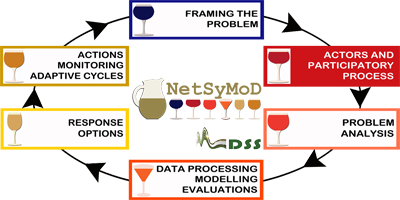Methodological Framework / Actors' Analysis
 What? [Description of step]
What? [Description of step]
This phase identifies the actors (i.e. all potential stakeholders/experts to be involved or affected by the decision under investigation) and their relationships within the local social context. It singles out those who should take active part in the decision making process. Very importantly, this phase identifies the intended end users of the decision procedure and, via support tools, it introduces them to the process and raises their motivation and ownership.
How? [Key methodological considerations and outputs]
The early involvement of the intended users and the relevant stakeholders is one of the most important success factors for decision support. The selection of participants is a crucial step in participatory processes, as it affects its legitimacy and quality. In NetSyMoD, the TFG (task force group) organises a sequence of meetings to develop a shared vision of the problem and identify the boundaries of the system, and to map all the actors to be involved (individuals or organisations with influence in, or that can be affected by, the decision).Social Network Analysis (SNA) techniques support the singling out of a core sub-set of representative stakeholders, by calculating indicators such as centrality and betweeness of key stakeholders, critical power relationships, etc..
The main outputs of this phase are: (i) the list of main actors to be involved; (ii) their social relevance and power relationships; (iii) existing value drivers and divides.





